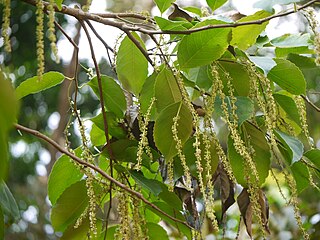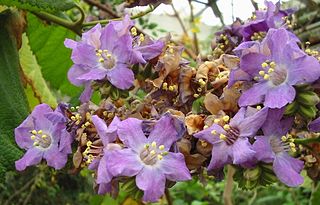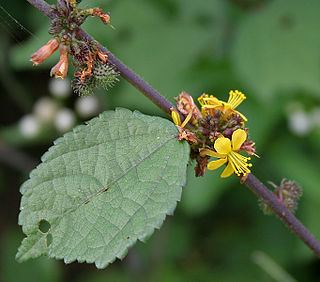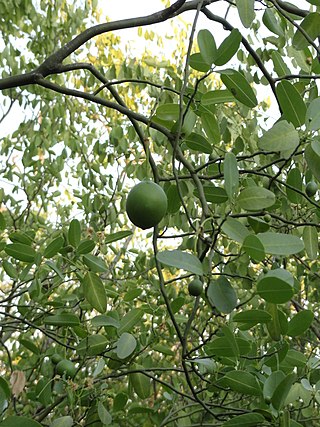
Brachystegia is a genus of tree of the subfamily Detarioideae that is native to tropical Africa.

Sesbania is a genus of flowering plants in the pea family, Fabaceae, and the only genus found in tribe Sesbanieae. Riverhemp is a common name for plants in this genus. Notable species include the rattlebox, spiny sesbania, and Sesbania sesban, which is used in cooking. Plants of this genus, some of which are aquatic, can be used in alley cropping to increase the soil's nitrogen content. The species of rhizobia responsible for nitrogen fixation in Sesbania rostrata is Azorhizobium caulinodans.

The mongongo tree, mongongo nut or manketti tree is a member of the family Euphorbiaceae and the monotypic genus Schinziophyton.

The Capparaceae, commonly known as the caper family, are a family of plants in the order Brassicales. As currently circumscribed, the family contains 15 genera and about 430 species. The largest genera are Capparis, Morisonia, Maerua, Boscia, and Cadaba.

Cleome is a genus of flowering plants in the family Cleomaceae, commonly known as spider flowers, spider plants, spider weeds, or bee plants. Previously, it had been placed in the family Capparaceae, until DNA studies found the Cleomaceae genera to be more closely related to the Brassicaceae than the Capparaceae. Cleome and clammyweed can sometimes be confused.

Hugh Iltis was a professor of botany and director of the herbarium at the University of Wisconsin–Madison. While he is most noted as a scientist for his role in the discovery of perennial teosinte, a wild diploid relative of modern maize, he is also remembered as an outspoken environmental conservationist.

Chionanthus, common name: fringetrees, is a genus of about 140 species of flowering plants in the family Oleaceae.
Neocussonia is a genus of flowering plants belonging to the family Araliaceae.

Capparis is a genus of flowering plants in the family Capparaceae. It includes 142 species of shrubs or lianas which are collectively known as caper shrubs or caperbushes. Capparis species occur over a wide range of habitat in the subtropical and tropical regions of Africa, Eurasia, Australasia, and the Pacific.

Homalium is a genus of plants in the family Salicaceae.

Cleomella is a genus of flowering plants. It includes 22 species of native to North America, ranging from southern Mexico through the western and central United States to western and central Canada. Like their relatives, the cleomes, plants of this genus have traditionally been included in the caper family Capparaceae but have recently been moved into a new family, Cleomaceae. Cleomella are annual wildflowers native to the dry and desert regions of western North America. They are similar to cleomes in appearance. They are erect and branching with leaves divided into three leaflets and inflorescences of yellow flowers with long stamens. Cleomella species are known commonly as stinkweeds or simply cleomellas.

Hans Schinz was a Swiss explorer and botanist who was a native of Zürich.

Wigandia is a genus of flowering plants within the waterleaf subfamily, Hydrophylloideae. They are found mainly in Central America and South America, though one or two species are found as far north as the United States. Some are grown as ornamental plants and will flourish in most Mediterranean or temperate regions. The genus is named for Johann Wigand, German Lutheran cleric and theologian, and Bishop of Pomesania.

Triumfetta is a genus of plants in the family Malvaceae. Burbark is a common name for plants in this genus.

Crateva is a genus of flowering plants in the caper family, Capparaceae. It includes 21 species which range through the tropical regions of the world, including the tropical Americas, sub-Saharan Africa, the Indian subcontinent, Indochina, southern China, Japan, Malesia, Papuasia, Queensland, and the South Pacific.

Pentagonia is a genus of over 40 species of plants in the coffee or gardenia family (Rubiaceae). Pentagonia species are native to Central America and northern South America, and grow in moist tropical forests below 900m. The genus was first described by George Bentham in 1845. Pentagonia are typically small monopodial trees up to 8 meters tall, but some are much-branched trees up to 18 meters tall. The genus is noteworthy for its large, entire and strongly carinate, interpetiolar stipules and large leaf blades, up to at least 200 cm long, with the leaf surfaces being distinctly and closely striate with fine epidermal fibers.

Saint Francis of Assisi Receiving the Stigmata is the name given to two unsigned paintings completed around 1428–1432 that art historians usually attribute to the Flemish artist Jan van Eyck. The panels are nearly identical, apart from a considerable difference in size. Both are small paintings: the larger measures 29.3 cm x 33.4 cm and is in the Sabauda Gallery in Turin, Italy; the smaller panel is 12.7 cm x 14.6 cm and in the Philadelphia Museum of Art. The earliest documentary evidence is in the 1470 inventory of Anselm Adornes of Bruges's will; he may have owned both panels.
Morisonia is a genus of flowering plants in the family Capparaceae, found across the Americas from the United States to Argentina. They are typically shrubs or small trees. The genus was recently enlarged with New World Capparis species due to existing taxonomic instability.
Mangleticornia is a monotypic genus of flowering plants belonging to the family Amaranthaceae. The only species is Mangleticornia ecuadorensis.

Morisonia speciosa, commonly known as bola verde, is a species of tree in the family Capparaceae. It is native to the Gran Chaco region of Bolivia, Paraguay, western Brazil, and northern Argentina. It was formerly known under the scientific names Anisocapparis speciosa and Capparis speciosa. The fruit, seeds, and flowers of Morisonia speciosa are edible. The fruit is very sweet and has a spicy flavor reminiscent of mangoes. The Toba and Wichí peoples traditionally use it both culinarily and medicinally.
















